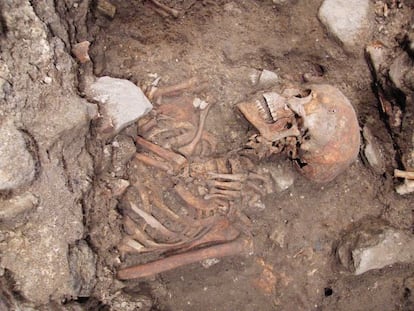Staring Black Death in the face in Barcelona
Archeologists uncover first mass grave of 14th-century plague victims to be found in Spain


The Basilica of Sant Just i Pastor, in the heart of Barcelona’s historic Gothic Quarter, has been a place of Christian worship since the fourth century. In recent years it has provided archeologists with rich bounty: Roman remains from the first century, when the colony of Barcino was founded by the emperor Augustus, along with a Visigothic baptismal font, and the chancel from a sixth-century basilica. The latest find is around 120 bodies packed like sardines in a mass grave under the sacristy that could provide new insight into the impact of the Black Death, which devastated Europe in the mid-14th century.
The plague is believed to have killed up to 30 million people in just six years after entering Europe in 1348. In Spain, the population fell from six million to two-and-a-half million. The epidemic hit Barcelona five times between 1348 and 1375.
Contemporary sources describe the efforts to stop the advance of the disease, but few archeological remains exist. Mass graves have been discovered in London, Prague, Marseille and Poitiers, but until now no burial sites had been found in Spain.
The excavation took place over the course of 2012, and shows that the burials were carefully carried out. The corpses were unclothed, and wrapped only in linen shrouds, lined up in rows, 11 bodies deep, and were then covered with quicklime dissolved in water to attempt to stop the disease spreading and mask the smell of the rotting bodies. Dominique Castex of the University of Bordeaux, who is coordinating the excavation as part of a broader investigation the institution is leading into the Black Death in Europe, says the find is unique and of great historical value: “This is the first such site we have found in Spain, and we believe it can tell us a great deal.”

DNA tests on the teeth of several of those buried in the mass grave carried out by the University of Tübingen show the presence of Yersinia pestis, a bacterium associated with rats and other rodents that was transmitted by the parasites they carried, particularly fleas, which injected it into humans when they bit them.
The initial symptoms of the disease were fever, shivering, nausea, thirst, exhaustion and trembling. Some victims’ glands would swell up in their groins, armpit and neck as the bacteria attacked the lymphatic system. The swellings are known as buboes, from which the word bubonic comes. Victims usually died within five days at most.
“When we began to exhume the remains it was clear that this was a mass grave from the time of the epidemic,” says Julia Beltrán, the scientific director of the excavation. “Bones had been very well preserved, and none of them showed any signs of the kind of damage that could have killed somebody. What’s more, there were people of both sexes, children, and of all ages. The victims were all buried within a short time frame.”
Despite the desperate situation at the time – few people were available to bury the mounting piles of dead, and the cemeteries were all full – great care was taken in laying out the victims: face up, with their arms by the sides or across their abdomen or chest, and the legs always fully stretched out.

The team has not been able to excavate the entire grave, which was partially dug up in the mid-15th century when the church was extended. The original grave would have been four meters long, 3.5 meters wide and 1.5 meters deep. Bearing in mind the density of the remains, the archeologists say that there would originally have been around 400 people in the grave. Aside from a small broach, no personal objects have been found.
The find suggests that unlike in London, where new cemeteries were built to bury the dead, in Barcelona, room was found in churches and churchyards for plague victims.
The remains found at Sant Just i Pastor are being kept in the church while they are examined, and will be reburied there, says Beltrán.
In September, the next phase of the archeological excavation of the interior of the church will begin, and the team says it is confident that Sant Just i Pastor will continue to yield clues about Barcelona’s past.
Tu suscripción se está usando en otro dispositivo
¿Quieres añadir otro usuario a tu suscripción?
Si continúas leyendo en este dispositivo, no se podrá leer en el otro.
FlechaTu suscripción se está usando en otro dispositivo y solo puedes acceder a EL PAÍS desde un dispositivo a la vez.
Si quieres compartir tu cuenta, cambia tu suscripción a la modalidad Premium, así podrás añadir otro usuario. Cada uno accederá con su propia cuenta de email, lo que os permitirá personalizar vuestra experiencia en EL PAÍS.
¿Tienes una suscripción de empresa? Accede aquí para contratar más cuentas.
En el caso de no saber quién está usando tu cuenta, te recomendamos cambiar tu contraseña aquí.
Si decides continuar compartiendo tu cuenta, este mensaje se mostrará en tu dispositivo y en el de la otra persona que está usando tu cuenta de forma indefinida, afectando a tu experiencia de lectura. Puedes consultar aquí los términos y condiciones de la suscripción digital.
Últimas noticias
How Japan is trying to avert ‘digital defeat’
From digital curfews to blocking apps: How technology experts protect their children online
Why the price of coffee has skyrocketed: from Brazilian plantations to specialty coffee houses
Confined to a Cuban hospital: When electricity is a matter of life or death
Most viewed
- Pablo Escobar’s hippos: A serious environmental problem, 40 years on
- Reinhard Genzel, Nobel laureate in physics: ‘One-minute videos will never give you the truth’
- Why we lost the habit of sleeping in two segments and how that changed our sense of time
- Charles Dubouloz, mountaineering star, retires at 36 with a farewell tour inspired by Walter Bonatti
- The Florida Keys tourist paradise is besieged by immigration agents: ‘We’ve never seen anything like this’








































